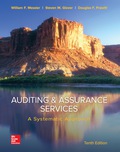
EBK AUDITING & ASSURANCE SERVICES: A SY
10th Edition
ISBN: 9781259293245
Author: Jr
Publisher: MCGRAW HILL BOOK COMPANY
expand_more
expand_more
format_list_bulleted
Question
Chapter 9, Problem 9.17MCQ
To determine
Introduction:
Substantive Procedures are designed and performed to detect material misstatement by ensuring the completeness, accuracy and validity of the data produced by the client’s system.
It is of two types:
- Test of Details
- Analytical Procedures
To describe: Sampling methods.
Expert Solution & Answer
Trending nowThis is a popular solution!

Students have asked these similar questions
Plz correct answer by best expert..
Plz correct answer by best solution?
Hello tutor finance
Chapter 9 Solutions
EBK AUDITING & ASSURANCE SERVICES: A SY
Ch. 9 - Prob. 9.1RQCh. 9 - Prob. 9.2RQCh. 9 - Prob. 9.3RQCh. 9 - Prob. 9.4RQCh. 9 - Prob. 9.5RQCh. 9 - Prob. 9.6RQCh. 9 - Prob. 9.7RQCh. 9 - Prob. 9.8RQCh. 9 - Prob. 9.9RQCh. 9 - Prob. 9.10RQ
Ch. 9 - Prob. 9.11MCQCh. 9 - Prob. 9.12MCQCh. 9 - Prob. 9.13MCQCh. 9 - Prob. 9.14MCQCh. 9 - Prob. 9.15MCQCh. 9 - Prob. 9.16MCQCh. 9 - Prob. 9.17MCQCh. 9 - Prob. 9.18MCQCh. 9 - Prob. 9.19MCQCh. 9 - Prob. 9.20MCQCh. 9 - Prob. 9.21PCh. 9 - Prob. 9.22PCh. 9 - Prob. 9.23PCh. 9 - Prob. 9.24PCh. 9 - Prob. 9.25PCh. 9 - Prob. 9.26P
Knowledge Booster
Similar questions
- If the car coast $28,000 and the interest rate is 8% and the term of payment is 6 years. How much would it cost you to pay for the car?arrow_forward43 -ACC-121-71: CH 04 HW-X Question 7 - CH 04 HW - Exercise X ezto.mheducation.com/ext/map/index.html?_con=con&external_browser=0&launchUrl=https%253A%252F%252Fconnect.mheducation.com%252Fcon vo Support L Lenovo McAfee Dashboard | Piedm... Information System... My Shelf | Brytewav... My Shelf | Bryteway... Exercises & Problems Saved Help Sa Scribners Corporation produces fine papers in three production departments-Pulping, Drying, and Finishing. In the Pulping Department, raw materials such as wood fiber and rag cotton are mechanically and chemically treated to separate their fibers. The result is a thick slurry of fibers. In the Drying Department, the wet fibers transferred from the Pulping Department are laid down on porous webs, pressed to remove excess liquid, and dried in ovens. In the Finishing Department, the dried paper is coated, cut, and spooled onto reels. The company uses the weighted-average method in its process costing system. Data for March for the Drying Department…arrow_forwardWith the growing popularity of casual surf print clothing, two recent MBA graduates decided to broaden this casual surf concept to encompass a "surf lifestyle for the home." With limited capital, they decided to focus on surf print table and floor lamps to accent people's homes. They projected unit sales of these lamps to be 7,600 in the first year, with growth of 5 percent each year for the next five years. Production of these lamps will require $41,000 in net working capital to start. The net working capital will be recovered at the end of the project. Total fixed costs are $101,000 per year, variable production costs are $25 per unit, and the units are priced at $52 each. The equipment needed to begin production will cost $181,000. The equipment will be depreciated using the straight-line method over a five-year life and is not expected to have a salvage value. The effective tax rate is 21 percent and the required rate of return is 23 percent. What is the NPV of this project? Note:…arrow_forward
- Forest Enterprises, Incorporated, has been considering the purchase of a new manufacturing facility for $290,000. The facility is to be fully depreciated on a straight-line basis over seven years. It is expected to have no resale value after the seven years. Operating revenues from the facility are expected to be $125,000, in nominal terms, at the end of the first year. The revenues are expected to increase at the inflation rate of 2 percent. Production costs at the end of the first year will be $50,000, in nominal terms, and they are expected to increase at 3 percent per year. The real discount rate is 5 percent. The corporate tax rate is 25 percent. Calculate the NPV of the project. Note: Do not round intermediate calculations and round your answer to 2 decimal places, e.g., 32.16. NPVarrow_forwardHelp with questionsarrow_forwardPlease help with questionsarrow_forward
- Create financial forecasting years 2022, 2023, and 2024 using this balance sheet.arrow_forwardBeta Company Ltd issued 10% perpetual debt of Rs. 1,00,000. The company's tax rate is 50%. Determine the cost of capital (before tax as well as after tax) assuming the debt is issued at 10 percent premium. helparrow_forwardFinance subject qn solve.arrow_forward
arrow_back_ios
SEE MORE QUESTIONS
arrow_forward_ios
Recommended textbooks for you
 Auditing: A Risk Based-Approach (MindTap Course L...AccountingISBN:9781337619455Author:Karla M Johnstone, Audrey A. Gramling, Larry E. RittenbergPublisher:Cengage Learning
Auditing: A Risk Based-Approach (MindTap Course L...AccountingISBN:9781337619455Author:Karla M Johnstone, Audrey A. Gramling, Larry E. RittenbergPublisher:Cengage Learning Auditing: A Risk Based-Approach to Conducting a Q...AccountingISBN:9781305080577Author:Karla M Johnstone, Audrey A. Gramling, Larry E. RittenbergPublisher:South-Western College Pub
Auditing: A Risk Based-Approach to Conducting a Q...AccountingISBN:9781305080577Author:Karla M Johnstone, Audrey A. Gramling, Larry E. RittenbergPublisher:South-Western College Pub

Auditing: A Risk Based-Approach (MindTap Course L...
Accounting
ISBN:9781337619455
Author:Karla M Johnstone, Audrey A. Gramling, Larry E. Rittenberg
Publisher:Cengage Learning

Auditing: A Risk Based-Approach to Conducting a Q...
Accounting
ISBN:9781305080577
Author:Karla M Johnstone, Audrey A. Gramling, Larry E. Rittenberg
Publisher:South-Western College Pub